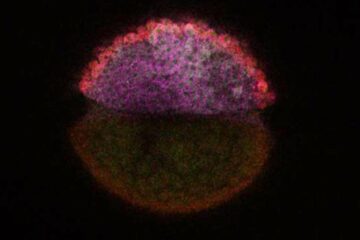Endogenous Proteins Found in a 70-Million-Year- Old Giant Marine Lizard

Using state-of-the-art technology, the scientists have been able to link proteinaceous molecules to bone matrix fibres isolated from a 70-million-year-old fossil; i.e., they have found genuine remains of an extinct animal entombed in stone.
With their discovery, the scientists Johan Lindgren, Per Uvdal, Anders Engdahl, and colleagues have demonstrated that remains of type I collagen, a structural protein, are retained in a mosasaur fossil.
Johan Lindgren, Anders Engdahl and Per UvdalThe scientists have used synchrotron radiation-based infrared microspectroscopy at MAX-lab in Lund, southern Sweden, to show that amino acid containing matter remains in fibrous tissues obtained from a mosasaur bone.
Previously, other research teams have identified collagen-derived peptides in dinosaur fossils based on, for example, mass spectrometric analyses of whole bone extracts.
The present study provides compelling evidence to suggest that the biomolecules recovered are primary and not contaminants from recent bacterial biofilms or collagen-like proteins.
Moreover, the discovery demonstrates that the preservation of primary soft tissues and endogenous biomolecules is not limited to large-sized bones buried in fluvial sandstone environments, but also occurs in relatively small-sized skeletal elements deposited in marine sediments.
A paper reporting the discovery, Microspectroscopic Evidence of Cretaceous Bone Proteins is now available in the scientific journal PLoS ONE.
Facts:
* Mosasaurs are a group of extinct varanoid lizards that inhabited marine environments during the Late Cretaceous (approximately 100-65 million year ago).
* Collagen is the dominating protein in bone.
* The scientists have applied a broad spectrum of sophisticated techniques to achieve their results. In addition to synchrotron radiation-based infrared microspectroscopy, mass spectrometry and amino acid analysis have been performed.
* Virtually all experiments have been made in Lund. At MAX-lab, the experiments have been conducted at the MAX I ring, beamline 73.
About MAX-lab
MAX-lab is a synchrotron light facility and a part of the MAX IV Laboratory. The MAX IV Laboratory is a national research laboratory comprised of the present MAX-lab and the MAX IV project. It is run by Lund University and the Swedish Research Council, and is situated in Lund, southern Sweden.
For more information, please contact: Dr Johan Lindgren
Phone. +46-(0)768-54 14 91, e-mail johan.lindgren@geol.lu.se. Department of Earth and Ecosystem Sciences, Lund University
Professor Per Uvdal, Phone. +46-(0)733-00 49 48, e-mail per.uvdal@chemphys.lu.se. Chemical Physics at Lund University,
and MAX-lab
Dr Anders Engdahl, Phone. +46-(0)768-93 77 08, e-mail anders.engdahl@maxlab.lu.se. MAX-lab
Media Contact
All latest news from the category: Earth Sciences
Earth Sciences (also referred to as Geosciences), which deals with basic issues surrounding our planet, plays a vital role in the area of energy and raw materials supply.
Earth Sciences comprises subjects such as geology, geography, geological informatics, paleontology, mineralogy, petrography, crystallography, geophysics, geodesy, glaciology, cartography, photogrammetry, meteorology and seismology, early-warning systems, earthquake research and polar research.
Newest articles

Attosecond core-level spectroscopy reveals real-time molecular dynamics
Chemical reactions are complex mechanisms. Many different dynamical processes are involved, affecting both the electrons and the nucleus of the present atoms. Very often the strongly coupled electron and nuclear…

Columbia researchers “unzip” 2D materials with lasers
The new technique can modify the nanostructure of bulk and 2D crystals without a cleanroom or expensive etching equipment. In a new paper published on May 1 in the journal…

Decoding development: mRNA’s role in embryo formation
A new study at Hebrew University reveals insights into mRNA regulation during embryonic development. The study combines single-cell RNA-Seq and metabolic labeling in zebrafish embryos, distinguishing between newly-transcribed and pre-existing…





















